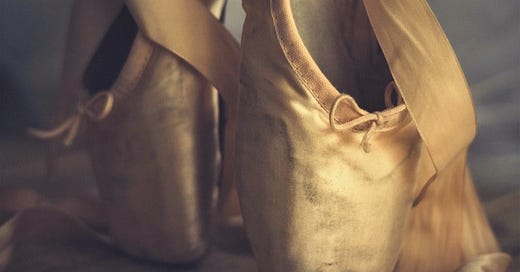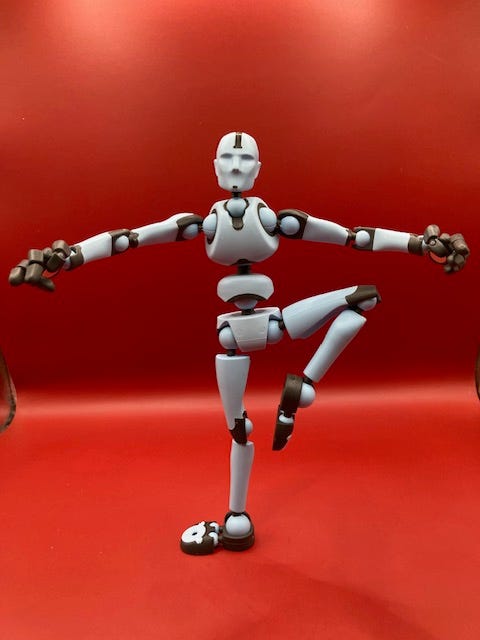French For Dancers: Développé
French For Dancers
Demystifying dance terminology and steps for dancers and dance-lovers!
Issue 25: Développé
Bonjour! Welcome to French For Dancers!
Bonne Année 2025 (Happy New Year!)
After an unplanned 3-week hiatus due to technical issues, French For Dancers is de retour (has returned)! My new laptop and I are also rested after the holidays and delighted to be back at work, in and out of the studio!
Parlez-Vous Ballet?
(Do you speak Ballet?)
DÉVELOPPÉ
(deh-vel-o-pay)
Développé means unfolded, or developed, coming from the French verb développer, to develop (another easy one to remember!).
Big développés are usually done towards the end of the barre, in adagio combinations, but the smaller version of the movement is also used in combinations using pas de cheval and fondu. Développés are also incorporated into allegro jumps.
A standard développé begins by drawing up the working foot to retiré, then lifting it through an attitude position into an extended straight leg, either forward (devant), side (à la seconde or de côté), or back (derrière).
In Cecchetti technique, the working leg can lift into a side retiré before taking the développé in any direction. In the Russian and French techniques, front retiré is used for front développé, back retiré for back développé, and front or back retiré for side développé, depending on where the working leg is coming from.
In any of these cases, it is important to keep the knee and thigh lifted to keep the working leg’s muscles engaged and to aid in a higher développé. Hips should remain square to the direction the dancer is facing, and not rotate in or out.
Développé can be done on flat foot, relevé, or even in plié, depending on the exercise or choreography. As students progress, port de bras (carriage of the arms) is introduced to complement the leg movement and help keep the upper body connected.
Savoir-Faire
(Know-How)
Student Tip:
It’s normal to focus on your working leg in développé, but don’t forget the standing, or supporting, leg - this is the one holding you up, after all! The standing leg should remain turned out and grounded to the floor, but should also provide lift to the body, with square hips (don’t sink into the standing hip or over tuck your pelvis).
For the working leg, the height of the extension is often determined by the height of the knee during the movement from retiré into the attitude, during the first part of the développé.
· To the side, aim the knee high and keep the inner thigh engaged to help the leg stay lifted and stable.
· To the back, keep the knee lifted the entire time, through the attitude and into the développé. Monitor your legs’ connection with your back – a strong back will help you with the extension.
· For a front développé, the front heel will lead the way, so keep your working foot as turned out as possible, while keeping both legs equally turned out as well.
Teacher Tip:
True to its meaning of developing or unfolding, développé is a fluid movement. Once students have learned the fundamentals of the static retiré/passé and attitude positions, they should work towards moving through them to the desired extension, rather than stopping at each point along the way. As they progress, they can slow the développé down, speed it up, add relevé or plié, or other movement combinations. Artistry and control remain paramount - even fast développés (such as those used in allegro or fouetté turns) are controlled, not flung.
It's also helpful to explain to students that they can use the développé concepts with their arms, gradually lengthening into an extended position from a shorter, rounder one (such as 1st to arabesque).
On the technical side, exercises strengthening and stretching the hip flexors, hamstrings, obliques, and back will go a long way to building long lines and beautiful extensions for your dancers.
À La Carte
(From the Menu)
Recommendations, reflections, and/or useful links
I was going to write an issue on Nutcracker Fun Facts in December, but due to the unfortunate demise of my former laptop, that will have to wait until next winter! However, here is a backstage glimpse into the workings of the Royal Ballet on how they create the snowy magic of The Nutcracker! (And, yes, they do recycle as much of it as they can!)
https://www.facebook.com/watch/?v=2170449723298049
Merci!
(Thank you!)
Thank you for reading this newsletter! If you have friends who might enjoy this, please share the link with them!
- Peggy








